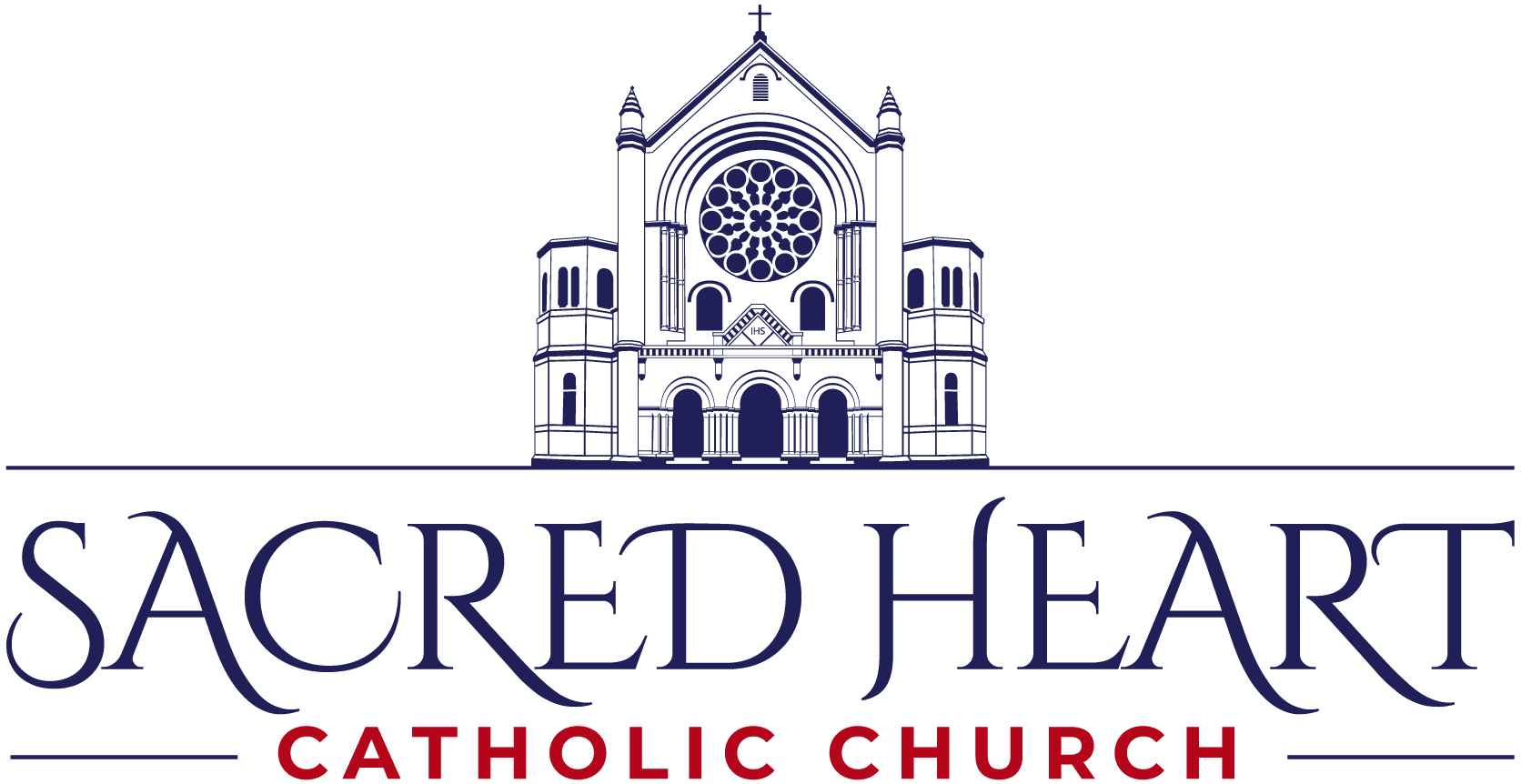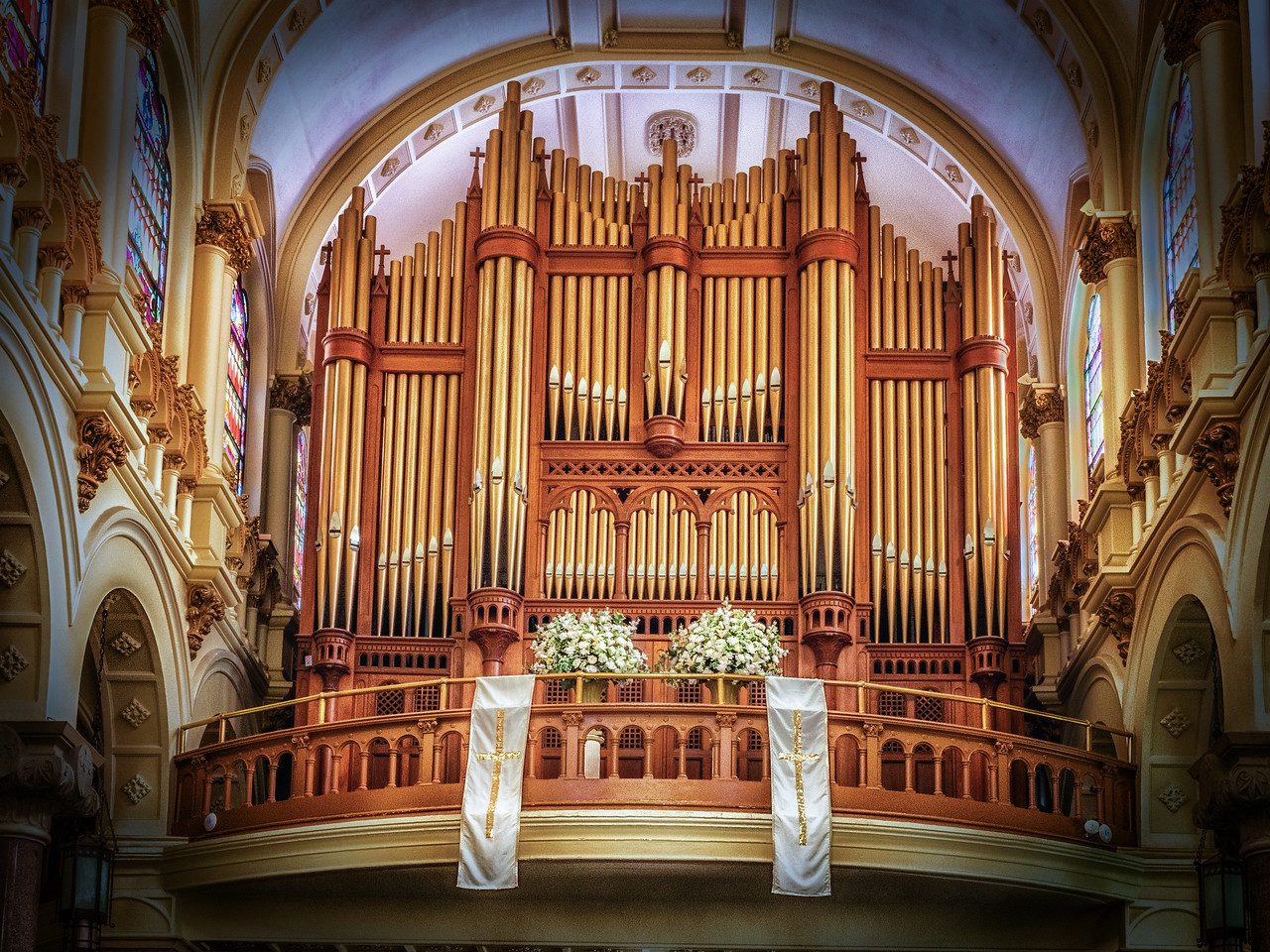“The musical tradition of the universal Church is a treasure of inestimable value, greater even than that of any other art. The main reason for this pre-eminence is that, as a combination of sacred music and words, it forms a necessary or integral part of solemn liturgy” (Sacrosanctum Concilium, no. 112). The composition and singing of inspired psalms, often accompanied by musical instruments, were already closely linked to the liturgical celebrations of the Old Covenant. The Church continues and develops this tradition: “Address . . . one another in psalms and hymns and spiritual songs, singing and making melody to the Lord with all your heart.” “He who sings prays twice” (Eph 5:19; St. Augustine, En. in Ps. 72,1:PL 36,914; cf. Col 3:16).
– Catechism of the Catholic Church, no. 1156
While Sacred Heart is synonymous with the Romanesque churches of the 19th century, and stands out amidst many of the surrounding modern structures in downtown Tampa as an unchanged part of our area’s history, the organ, or organs the church has played home to over the last 120 years are one of just a few instances of updated infrastructure within the church, even if elements of what we are accustomed to seeing and hearing today are only a few years younger than the church itself. Here is a timeline of our church’s organs and updates:
1889: The First Organ (Estey Co.)
The first record of an organ in what was then St. Louis Church, our preceding parish, appeared on August 1, 1889, when a 22-stop , 2-manual (or 2 keyboards) organ with pedals was installed in the original wooden structure off of Zack Street. The picture below shows an Estey organ from the same period.

Estey Organ Company made its name as a manufacturer of reed organs, also known as harmoniums. When interest in reed organs waned at the start of the 20th century the company moved to production of small pipe organs.
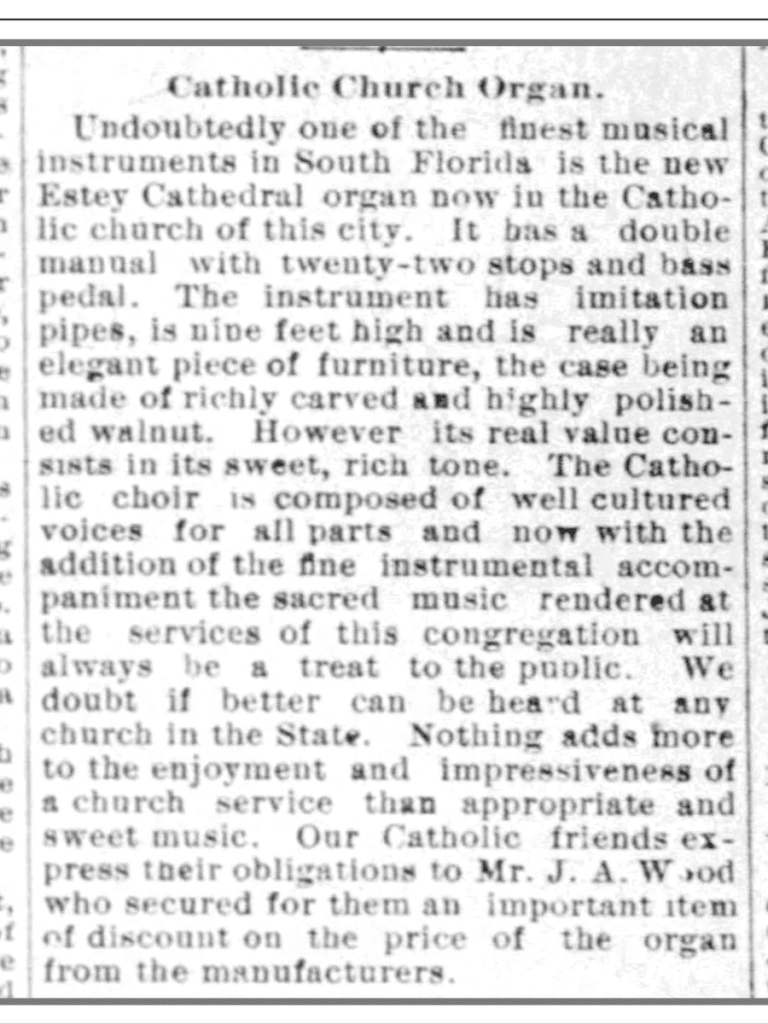
The description in the record of ‘an elegant piece of furniture’ and the fact that the St. Louis Church organ dated from 1889 both indicate that this was likely a large reed organ and not a pipe organ at all. If you wish to hear how it might have sounded an Estey Organ from 1892 may be seen and heard by clicking here.
1905: The Unknown Organ
A blurb from the Tampa Tribune’s coverage of the dedication of Sacred Heart Church (January 15, 1905) of refers to the organ loft being “occupied by a small pipe organ, which later will be exchanged for one more in proportion to the size of the building.” The ‘small pipe organ’ was most probably the Estey Reed organ which had only decorative pipes in its case.
A report of a warehouse fire from the Tribune later that year (dated July 27, 1905) mentions organ parts destined for the new church of Sacred Heart narrowly escaping damage. “One very important item of freight in the warehouse during the fire was the fine new pipe organ for the Catholic Church of the Sacred Heart. Seven boxes of equipment was on hand and none are thought to be injured.” Additional updates from the Tribune in September, 1905, state “The big pipe organ for the Catholic Church of the Sacred Heart is arriving , in sections, and is being erected in the choir loft of the church (9/6/1905),” and “the new organ for the Catholic church, which has recently been completed will be used this morning (9/24/1905)” Certainly by September the organ was being used, but we have little to no details about it.
1911: Pilcher Opus 721
According to the Organ Historical Society database, Henry Pilcher, of St. Louis, MO, and later New Orleans, LA, installed his Opus 721 in 1911. This was a 2-manual instrument costing the church $1600. This pipe organ may have been a second-hand Pilcher organ from the Third Presbyterian Church of New Albany, IN. The casework from this instrument is what we see today.
We can find no other documentation regarding this instrument. From 1906 to 1910, the firm was listed as W.&C.H. Pilcher (William and Charles H.) but William alone is listed as an organ builder in 1911. He died in 1912.
1927: Moller Organ
The OHS database shows that Moller retained the existing case for his 1926 instrument.
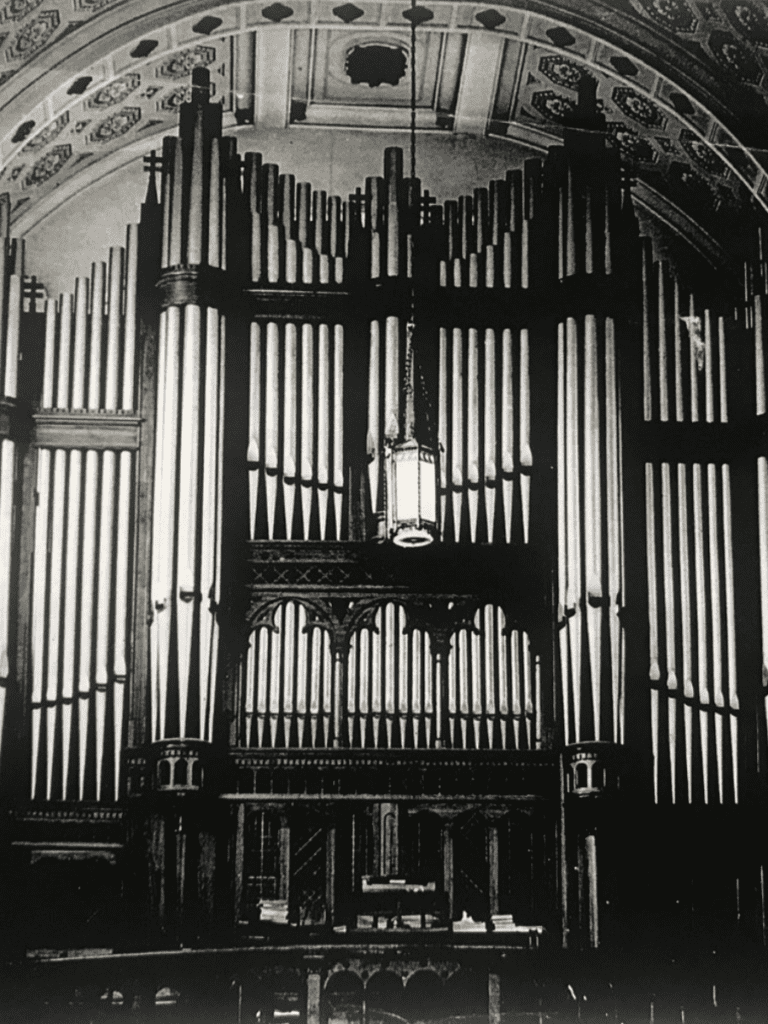
From our archives, we have a copy of the contract with M.P. Moller of Hagerstown, MD. to produce a 4-manual and pedal organ of 88 speaking stops with additional chimes (1), harp (2) and tremulants (4). Found during a later rebuild of the inside the Pedal 16’ trombone palette board, together with an address “126 Avenue, Hagerstown, MD” were the following names: George Baker , Dan Saunders, Paul Brown, J.B. Black, Mel Kuhn, Claudy Culpes, Buck Rulen, Goofy Wilhide. It is thought that these were the craftsmen involved in the manufacturing of the instrument.
This new organ is mentioned in a Jesuit rector’s journal entry dated February 24, 1927 “A magnificent Grand Organ was installed in our church and for the first time was used today. It is due to Fr. Doonan’s untiring efforts that this organ was purchased at a handsome sum of $30,000.” The memorandum of agreement shows the final purchase price as $29,350.
In the March 19, 1927 Tampa Tribune, the arrival of the new organ is foretold. H.E. Toenjes of M.P. Moller is noted as having supervised the production of the instrument consisting of 137 registers and 5000 pipes. The number 137 seems high, and might refer instead to the number of tabs and draw-stops, which would have included couplers and tremulants, etc. Possibly the number may also have included stops, with mixtures would have comprised as many as four ranks of pipes.
At the time, this was the largest organ in Florida. It was extraordinary to find such symphonic organs in Catholic churches when during this time so much of the liturgical music was unaccompanied, or lightly-accompanied Latin plainsong. It was probably due to the Jesuits experience of organs in Europe, particularly in France, that derived the size of the installed instrument. The prevailing fashion at the time was to build large instruments capable of playing arrangements of classical orchestral music.
Without doubt, the organ deteriorated significantly over the following decades and its size would have meant that maintenance costs would have been high. By 1985, the organ was rarely used and hardly functioned. From a 1991 concert program for the dedication of the renovated instrument, organist Dr. David Isele reported that when he first came to play at Sacred Heart in 1985, three divisions of the organ were inoperable, with the rest poorly functioning. An electric instrument of unknown origin was placed in the side transept, and the choir moved down to join it. Isele dreamed that one day, the noble tones of the 1927 Moller Organ might ring out in a manner which complimented the outstanding architecture of our church.
A letter dated August 15, 1989 to Dr. David Isele from Walter Holtkamp of the Holtkamp Organ Company makes a clear case for scrapping the Moller Organ, which he described as “not blending sounds,” but “very opaque solo sounds….not designed to support congregational singing or even choirs.”
The Moller Organ Company was invited to tender an offer to restore the organ. In a letter from the company dated December 7, 1989, they urged the restoration to the original 1927 scheme which the writer, Daniel Angerstein, claimed was back in vogue. He recommended some tonal revisions to further develop the plenum. Dr. David Isele and his committee were not convinced by Angerstein’s advice and decided to follow Holtkamp’s advice and sought a new organ.
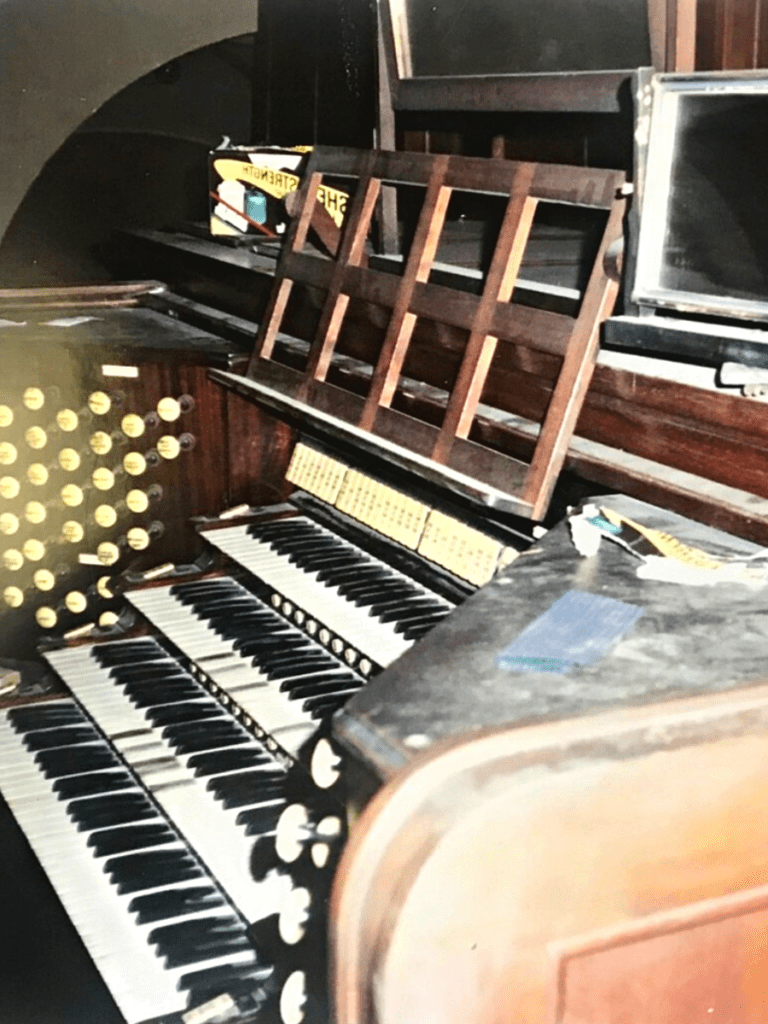
1991: The Wicks Organ
In 1990, after considering several offers, the Wicks Organ Co. was chosen to reconstruct and redesign a pipe organ within the existing Pilcher Case. The plans included a reduction from four-manuals to three, and from 88 stops to 48. Changing tastes in organ design and the considerable maintenance costs will have influenced the reductions. Essentially, this was a new organ which included some of the pipework from the 1927 Moller Organ. The specification is largely the same as exists today. A new 3-manual console was provided by Wicks to replace the original console. The console was originally installed in the choir loft.
Moving the Console: In a letter dated September 14, 2009, organist Sean Fitzsimmons-Brown raised the possibility of moving the console to the side transept. This work was carried out by Wicks and Point Builders. The Wicks console was transferred to the side transept (where the electric instrument had been installed) and cabling supplied the relay to the pipework in the choir loft.
Repairs to windchests and pipes retained from the Moller Organ: A letter dated February 10, 2012 from Fitzsimmons-Brown requested from the Friends of Sacred Heart, a former historical preservation arm of the church, funding of $11,356.00 in respect of work done to the original Moller pipes and windchests of the pedal division. It was determined that the pipes and windchests were immovable because of their size. Fitzsimmons-Brown advised that on completion “those stops will be able to work as they should for another eighty to ninety years.”
Following a positive response from the Friends of Sacred Heart, organ builder Bill Longmore, detailed the re-leathering of the original Moller pipe valves and primary valves (Pedal: Stentorphone 16, Open diapason 16, Violone 16, Bourdon 16, Trombone 32, Quinte 10 2/3 and Swell: Bourdon 16). Longmore pulled the pouch board and primary rails out of the organ for re-leathering in his shop. In June, 2012, Elaine Carbonneau, a representative of the Friends of Sacred Heart, reported that the work was completed by Bill Longmore and his then 20-year old grandson, Nick. The windchests were opened and the palette boards were removed so that each air conduit could be re-leathered. The windchests were also cleaned before being closed and sealed.
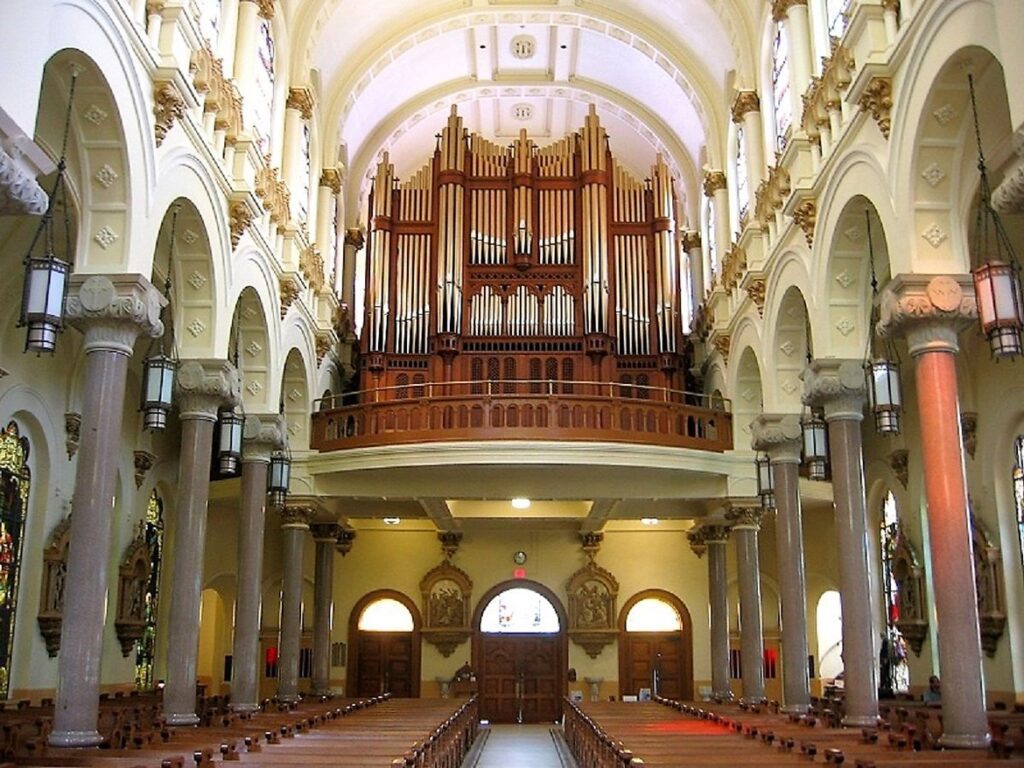
A division of the organ for the transept: In 2015, the parish explored with Mr. Longmore the possibility of creating a 4-rank pipe division to accompany the choirs in the transept, but these came to nothing. It is possible that this exploration was considered to provide a more immediate accompaniment to the choir than the remote pipework could ever do.
Concern about the blower: In 2015, Mr. Longmore also provided a proposal for repair to the original Moller blower. There is uncertainty as to whether any work was actually done, but there was some electrical work done to the blower supply. In the years that followed, organists reported a recurrence of the organ cutting out. It is not clear whether this was down to the extreme heat in the blower chamber or some other electrical fault. The temperature in the blower chamber is excessive at certain times of the day, especially in the heights of summer, with the humidity which ends up being pumped into the organ is not good for the survival of the instrument.
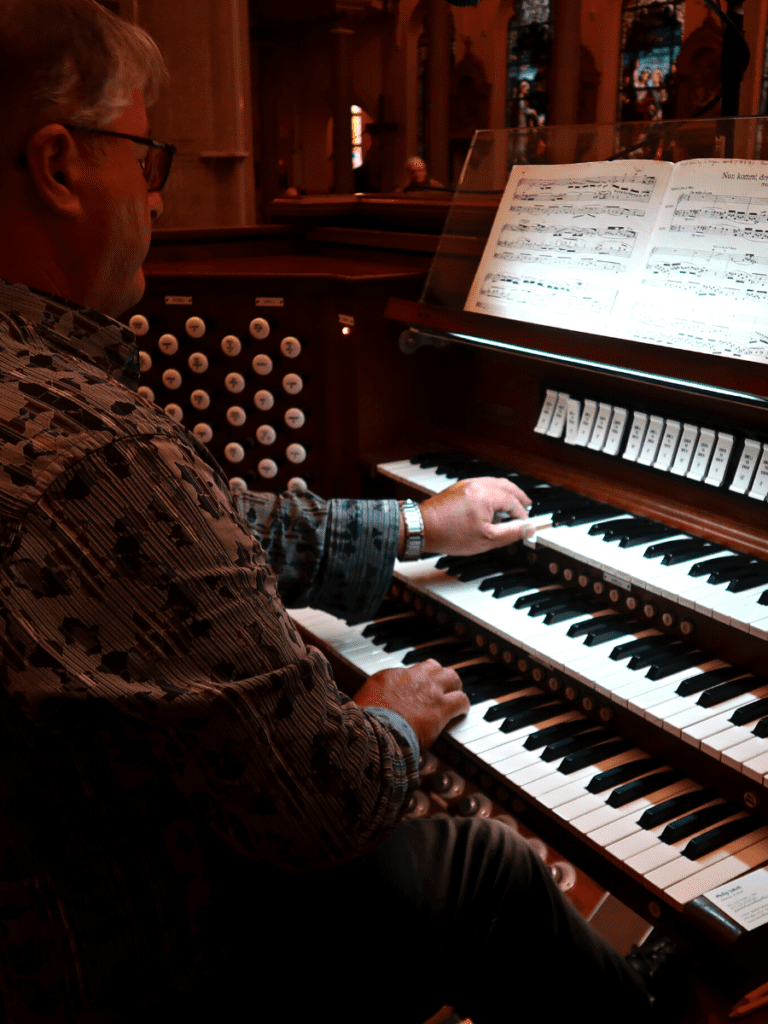
with Philip Jakob, Director of Music
Concern about the console and leatherwork: In 2022, Philip Jakob, the parish’s director of music since 2021, reports that there are early signs that the leather repairs of 2012 have deteriorated. Similarly, the Wicks console is beginning to show its age. Several notes are not sounding, the action noise from the manuals is extraordinarily loud and the capture system for the combination pistons is becoming unreliable.
